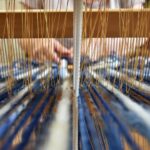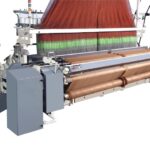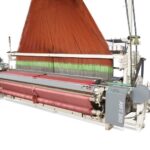How to Avoid Abrasion of Rapier Head and Rapier Belt of Rapier Loom?
How to Avoid Abrasion of Rapier Head and Rapier Belt of Rapier Loom?

Rapier looms are reliable partners in the tricky dance of textile production, bringing together creative ideas and the ability to make a wide range of fabrics. The rapier head and rapier belt are very important parts of these tools because they move the weft yarn quickly and accurately through the warp. However, like many mechanical surprises, rapier looms need to be carefully watched over and maintained to make sure they keep working well. One of the biggest problems that loom workers have to deal with is the chance that the rapier head and belt will get worn down. Because of friction and wear, abrasion can cause expensive repairs, downtime, and damaged fabric first-class. So, it will be very important for companies that make fabrics to take precautions to protect these important parts. In this guide, we’ll look at five important tips that will help manufacturers keep the rapier head and belt on rapier looms from wearing down, so that production doesn’t stop and the best results are achieved.
1. Regular Lubrication:
Proper lubrication is crucial to reduce friction and wear on the moving components of the rapier loom, which include the rapier head and belt. Use extremely good lubricants recommended via the manufacturer and adhere to the required lubrication agenda. Regular software of lubricants will ensure easy operation and decrease the chance of erosion resulting from friction.
2. Monitor Tension Levels:
Maintaining the precise anxiety stages inside the rapier belt is essential for stopping abrasion and prolonging its lifespan. Periodically test the anxiety of the rapier belt and make adjustments as needed to make sure it’s far neither too loose nor too tight. Improper tension can motivate immoderate put on each the belt and the rapier head, leading to premature failure.
3. Cleanliness is Key:
Maintaining the precise anxiety stages inside the rapier belt is essential for stopping abrasion and prolonging its lifespan. Periodically test the anxiety of the rapier belt and make adjustments as needed to make sure it’s far neither too loose nor too tight. Improper tension can motivate immoderate put on each the belt and the rapier head, leading to premature failure.
4. Proper Alignment:
Misalignment of the rapier head and belt can boom friction and result in improved put on and tear. Periodically take a look at the alignment of the rapier head and belt according to the manufacturer’s specifications. Adjustments may be important to make certain that the components are nicely aligned for easy and efficient weaving.
5. Train Operators:
Proper schooling of operators is crucial for the effective operation and upkeep of rapier looms. Ensure that operators are familiar with the device’s operation manual and are trained to become aware of capability problems along with unusual put on or symptoms of damage to the rapier head and belt. Encourage a way of life of proactive preservation to deal with any problems directly and save you from escalating.
6. Implement Routine Inspections:
Establish an agenda for recurring inspections of the rapier head and belt, as well as other crucial components of the loom. During those inspections, look for signs of wear and tear, harm, or capability areas of the subject. Address any troubles directly to save you from worsening and inflicting abrasion or other operational troubles.
7. Invest in High-Quality Components:
Select top-notch rapier heads and bands that are especially made to be strong and durable. Investing in better chemicals may cost more at first, but it will pay off in the long run by lowering the number of times that repairs and replacements are needed due to abrasion and other types of wear.
Stopping the rapier head and rapier belt from wearing down on rapier looms is very important in the fast-paced world of textile making, where every thread counts and efficiency is key. These extras are what keep the weaving process going. They guide the yarns precisely and quickly to make the fabric that decorates our lives. However, if they are not taken care of properly, friction and wear can damage them, leading to costly repairs, downtime, and goods that are not up to par.
By following the seven important tips in this guide, including regular lubrication and stress monitoring, as well as cleanliness, alignment checks, operator training, regular inspections, and spending money on food additives fabric manufacturers can make their rapier looms more resistant to wear and tear. Manufacturers can make sure that their machines run smoothly, last longer, and keep making awesome fabric by putting in place regular maintenance plans and a commitment to greatness.
Ultimately, the quest to stop the rapier head and belt from wearing down on rapier looms isn’t just about protecting tools; it’s about protecting the integrity of the whole production system. It’s about maintaining a high level of quality in every part of the cloth production process, from the weaving room to the finished product. By putting preventative maintenance first and investing in the strength of their equipment, manufacturers can stay ahead of the curve, reduce downtime, and set themselves up for success in an industry that is always changing.
In the weaving process of textiles, each thread and part is very important to the creation of something bigger than itself. By taking care of the rapier’s head and belt, makers help make their craft a seamless tapestry of new ideas, creativity, and fine craftsmanship. Producers can face the challenges of wear with confidence if they work hard, plan ahead, and are dedicated to doing their best. They’ll know they can get through any problem and keep weaving the fabric of their success. Explore the range of services offered by Weavetech to get complete help and professional advice on how to take care of and improve the performance of your rapier looms. From preventative maintenance packages to cutting-edge technology, Weavetech is the company you can trust to make sure your textile making system lasts and works well. Get in touch with us right away to learn more and start your road to seamless weaving excellence.






